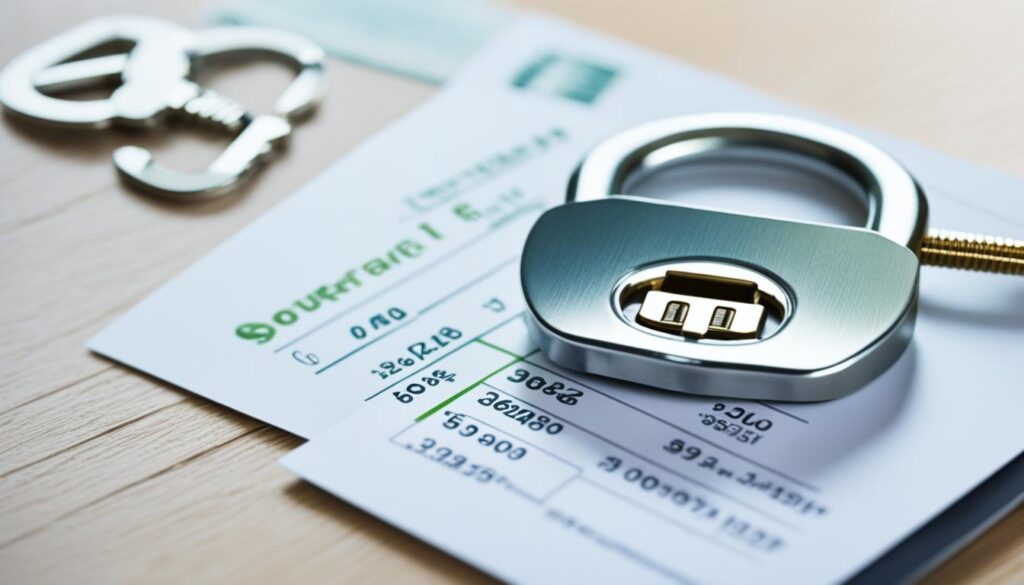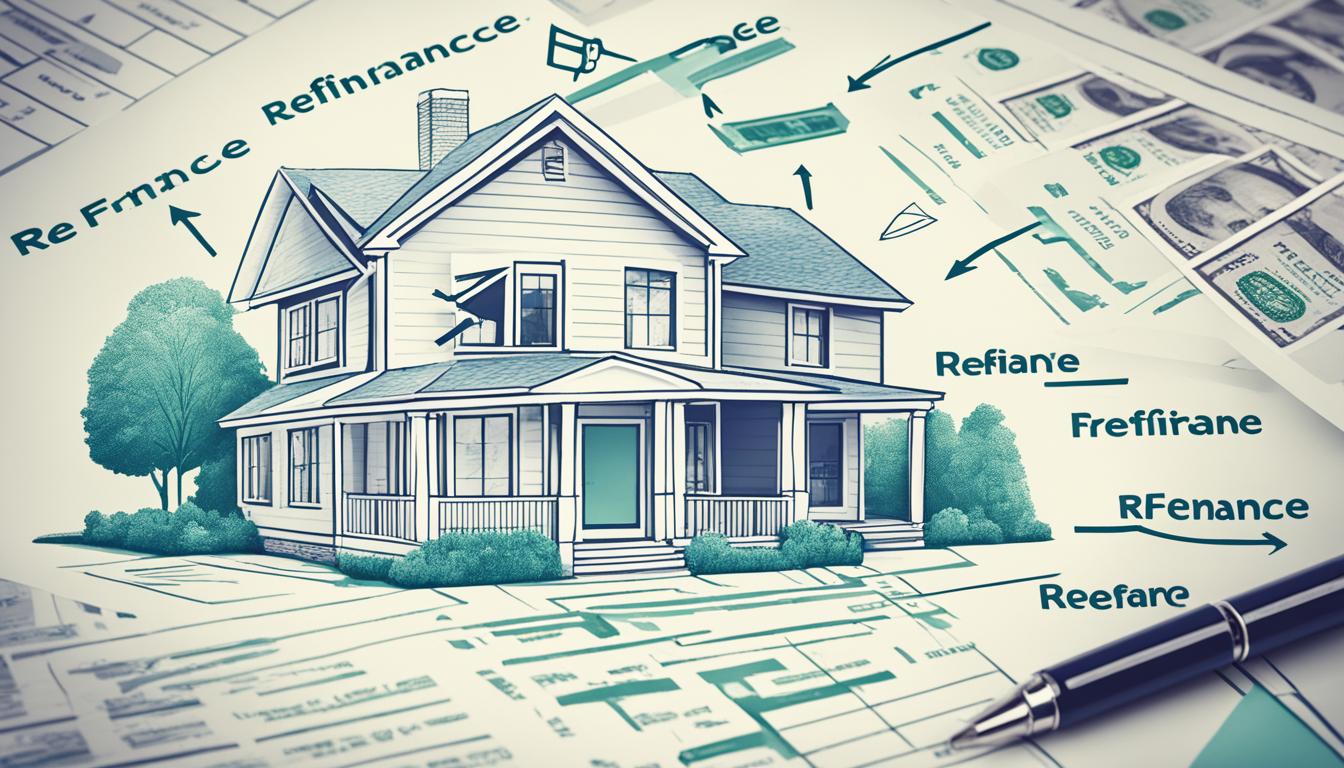Refinancing a mortgage lets homeowners change their current loan terms. This offers more financial freedom and can lead to savings. By adjusting the interest rate and loan duration, they can better fit their financial needs.
Different refinancing options are out there, like rate and term refinance or cash-out refinance. Which one you pick depends on what you aim to achieve with your home loan.
Choosing the right mortgage lender is key when thinking about refinancing. It’s important to look at interest rates, how accessible they are, and what customers say. This ensures the new loan fits well with your budget.
Getting your paperwork in order is a big part of refinancing. Expect the lender to ask for things like pay stubs and bank statements. If you work for yourself, you might need to provide extra proof of income.
Underwriting is crucial in the refinance process. Lenders will look closely at your financial info, check your house’s value, and may even do a new appraisal. This helps them decide how much you can borrow.
Once everything’s set, closing on the new loan is the last step. You’ll get a document with all the loan details before signing the papers. At the closing, you’ll pay any fees and possibly get cash back.
Key Takeaways:
- Mortgage refinance allows homeowners to adjust the terms of their current home loan for better financial flexibility and potential savings.
- There are different types of refinancing options available, including rate and term refinance, cash-out refinance, cash-in refinance, and no-closing-cost refinance.
- Choosing the right lender is crucial in finding the best terms for a refinanced mortgage. Consider factors such as interest rates, availability, and client satisfaction scores.
- Gathering necessary documents, such as pay stubs and bank statements, is essential when applying for a mortgage refinance.
- Underwriting and home appraisal play a significant role in determining loan amounts and eligibility for different refinance options.
Types of Mortgage Refinance Options to Consider
When you think about refinancing your mortgage, knowing your options is vital. There are four main kinds to consider.
1. Rate and Term Refinance
A rate and term refinance changes your current mortgage’s interest rate and terms. It’s good for getting a lower interest rate, making the loan shorter, or switching from an adjustable to a fixed rate.
This chance helps improve your loan’s money side without losing equity. You won’t get cash back from this type of refinance.
2. Cash-Out Refinance
In a cash-out refinance, you get a new loan for more than what you owe. The leftover money is yours. You might use it for home upgrades, merging debts, or reaching other money goals.
It’s an important loan decision. You’re borrowing more. Think well about this and be sure it fits your money plan.
3. Cash-In Refinance
A cash-in refinance is the opposite. You pay extra toward your mortgage. This boosts your home’s equity and cuts your debt.
It might help improve your loan terms or interest rate. It’s useful if you want to get rid of private mortgage insurance or better your loan-to-value status.
4. No-Closing-Cost Refinance
With a no-closing-cost refinance, you add the closing costs to your new loan’s balance. This avoids upfront payments. It looks good for those who want to delay paying the costs of refinancing.
But, it could mean more interest paid over time. Make sure to think about the full cost.
Choosing the best option hinges on your aims and financial situation. Always talk to a mortgage expert before deciding.
Refinance Types Comparison Table:
| Refinance Type | Description |
|---|---|
| Rate and Term Refinance | Allows borrowers to change the interest rate and loan terms of their current mortgage without cashing out equity. |
| Cash-Out Refinance | Borrowers take out a new loan of a larger amount and receive the difference between the two loan amounts in cash. |
| Cash-In Refinance | Homeowners contribute a lump sum to increase equity and decrease the amount owed on the mortgage. |
| No-Closing-Cost Refinance | Closing costs are rolled into the principal of the new loan instead of being paid upfront. |
Choosing the Right Lender for Your Mortgage Refinance
Once you pick a refinance type, selecting the right lender is key. Don’t just stick with your current lender. It’s smart to check out others too. Comparing offers from different lenders helps you get the best deal for your refinance.
Consider a lender’s interest rates closely. Lower rates mean you pay less each month and save more over time. Take time to look at what rates various lenders are offering. This helps you pick the best mortgage for you.
Don’t overlook how easy a lender is to reach either. It’s good to choose someone who responds quickly when you need them. Make sure they have clear ways to get in touch and dedicated staff to help you.
Checking a lender’s client satisfaction scores is also wise. These scores show how happy people were with their service. Testimonials and reviews can reveal a lot about a lender’s reputation and how they treat their customers.
Comparing lenders not only lets you find the best rates and services, but it also shows you which ones have the most satisfied customers. The right choice can bring confidence in your refinance and help you reach your financial targets.
Case Study: Client Satisfaction Scores Comparison
| Lender | Client Satisfaction Score |
|---|---|
| ABC Mortgage | 4.8/5 |
| XYZ Lending | 4.5/5 |
| 123 Bank | 4.3/5 |
In our sample, ABC Mortgage got the best satisfaction score. This shows they excel in customer service. But don’t forget to look at rates and how easy they are to work with.
Finding a lender with great rates, excellent communication, and happy customers is important. It makes your refinancing journey smooth and fits your needs well.

Gathering Documents and Applying for a Mortgage Refinance
Considering a mortgage refinance means you’ll need to gather some documents. The info you give now is similar to when you first bought your home. Lenders want to see these documents to check your finances. This helps them decide if you can refinance. Having these papers ready makes the process faster.
Documents Required for a Mortgage Refinance
Here’s what you’ll need when getting a mortgage refinance:
- Income Documents: You should show your two latest pay stubs if you work for someone. If you’re self-employed, you might need more info, like tax returns or profit statements.
- Asset Documents: Collect your two most current bank statements. These show your assets, like savings and investments.
- Debt Documents: Make a list of what you owe, like credit cards or loans. Lenders might need more details to check how your debts compare to your income.
- Credit Score: Your credit score is really important. It affects if you can get a loan and what your interest rates will be. Always know your credit score when you’re thinking about refinancing.
It’s smart to keep these documents on hand for your refinance. Remember, you might need to show extra paperwork based on your finances and what the lender wants.
“Gathering the necessary documents when applying for a mortgage refinance allows lenders to assess your financial stability and determine your loan eligibility.” -[Name]
With all the documents ready, you can start the refinance application. Make sure the information you provide is accurate and complete. This smooths out the process for the lender to review.
After the lender looks at everything, they’ll decide if you can refinance. This decision includes the new loan’s terms and conditions. Refinancing can help you reach your money goals and enhance your ownership journey.
Locking in Your Interest Rate for a Mortgage Refinance
After getting approved for a mortgage refinance, you face a crucial choice. It’s about locking in your interest rate or letting it float. Each path comes with benefits and downsides that are good to understand.
Rate Lock: Stability and Peace of Mind
A rate lock makes sure your interest rate stays the same until the loan closes. This can bring a lot of stability and peace of mind. It’s helpful if you’re worried about rates going up.
Locking in your rate lets you enjoy today’s low rates. You won’t worry about rates going up either. This means you can plan your budget easier, knowing your payments are set.
But, remember, rate locks come with a time limit. If your loan takes longer to close, you might have to pay extra to extend the lock. Make sure to talk with your lender. Understand any fees for extending the rate lock.
Floating the Rate: Potential for Lower Rates
Floating the rate is choosing not to lock your interest rate. It means the rate can change until the loan closes. This might let you get a lower rate if the chance comes up.
If you float the rate, watch the market and stay in touch with your lender. This helps you pick the best time to lock in your rate.
Going with this option could help you save money. Yet, if rates go up, you might end up with a higher rate than you expected.

Choosing Your Strategy: Pros and Cons
Each choice, locking your rate or letting it float, has its own set of positives and negatives. Here’s what you need to know:
| Rate Lock | Floating the Rate |
|---|---|
| Stability and predictability for budgeting | Potential to take advantage of lower rates |
| Protection against future rate increases | The risk of rates increasing |
| Peace of mind during the closing process | Requires careful monitoring of market conditions |
| Potential additional costs if the rate lock needs to be extended | No guarantee of getting a lower rate |
Your choice depends on your own situation and risk level. Talk with your lender. Consider all the pluses and minuses before you decide.
Underwriting and the Importance of a Home Appraisal
After you apply for a mortgage refinance loan, the underwriting process begins. This step is vital, checking the accuracy of your financial details. They also look at the property’s value and any changes since you bought it. The home appraisal is a big part of this step.
The home appraisal is key in the refinance process. It decides what refinance options you have. A pro appraiser checks your home’s value using things like the area, its state, and what similar homes sold for. This helps figure out things like loan amounts and what loan choices you qualify for.
Getting an exact home appraisal is important for you and the lender. It makes sure the refinance loan matches what your property is really worth. This reduces the chance of overvaluing or undervaluing your home. A good appraisal also helps set fair loan terms.
In the end, underwriting and a home appraisal are crucial in refinancing. Underwriting confirms your financial information while the appraisal gauges your property’s value. These processes help select the best loan options for you. They make sure your refinance meets your financial hopes.
| Key Points | Importance |
|---|---|
| Underwriting | Verifies financial information |
| Home Appraisal | Assesses property value |
| Loan Amounts | Determined based on appraisal |
| Mortgage Payments | Influenced by property value |
| Eligibility for loan options | Determined by appraisal |
The Refinance Appraisal Process
Refinancing, like buying a home, needs an appraisal. The lender organizes this. An appraiser comes to your house to figure out its value. This step is key for knowing what the property is worth.

It’s smart to get your home looking its best before the appraisal. Fixing up things and cleaning can make a big difference. These steps might even raise the home’s value.
If you’ve upgraded parts of your house, tell the appraiser everything you’ve done. This can be changing the kitchen, redoing bathrooms, or making your home greener. Showing off these changes could boost your home’s value.
The appraiser considers many things to decide your home’s value. This includes its size, condition, and where it is. They also look at similar recent sales and the current market.
The appraisal result can make or break your refinancing. If it matches your loan amount, things go forward easily. However, if it’s lower, the lender might need to adjust your loan.
Understanding the appraisal is crucial for a successful refinance. Know the value of your home, ready it for appraisal, and ensure the appraiser knows of any upgrades. This way, you can make the best decisions for your refinancing.
Refinance Appraisal Checklist
- Tidy up the home and make necessary repairs
- Compile a comprehensive list of all upgrades made since owning the home
- Provide necessary documentation to support the upgrades
- Research recent sales in the area to understand market trends
- Prepare any supporting documentation related to property improvements or renovations
- Be present during the appraisal to answer any questions the appraiser may have
| Benefits of a Positive Refinance Appraisal | Importance of Upgrades |
|---|---|
| A higher appraised value can result in lower interest rates | Upgrades can enhance the overall value of your property |
| Access to better loan terms and conditions | Recent upgrades can sway the appraiser’s perception of your home’s condition |
| Potential for increased savings over the life of the loan | Upgrades can help differentiate your property from others in the area |
Closing on Your Mortgage Refinance
After the underwriting and home appraisal, it’s time to close your mortgage refinance. This step gets you closer to securing better loan terms. It also lets you start benefiting from possible financial gains.
Before closing, borrowers get the Closing Disclosure. This vital document shares the final details and numbers for your refinance. It makes sure everything is clear and accurate.
The refinance closing is usually quicker than buying a house. You’ll go over and sign the loan papers. Making sure you understand the terms is key. Be sure to read everything thoroughly to prevent future surprises.
Paying the closing costs is also part of this stage. These costs might be for appraisals, inspections, or credit checks. You might pay these costs upfront or add them to your loan amount.
If you’re getting cash from your refinance, it might be for any personal expenses. Maybe to improve your house or clear debts. This happens in a cash-out refinance.
After closing, you get a 3-day chance to cancel the refinance if you change your mind. This is to let you review everything one last time. It’s important for making sure you’re okay with the deal.
Key Takeaways:
- After underwriting and the appraisal, borrowers can move to the closing of a mortgage refinance.
- The Closing Disclosure shares all the final loan details and numbers.
- Refinance closings are often faster than home purchase closings.
- At closing, borrowers sign important papers, pay any closing costs, and might get extra funds.
- Borrowers have 3 days after closing to change their mind and cancel the refinance.
When to Consider Refinancing Your Mortgage
Refinancing your mortgage can be a wise move for many homeowners. It gives you a chance to change your loan’s terms for the better. This is helpful in a few situations:
- To pay less each month by securing a lower interest rate. This saves money over the loan’s life and boosts your financial health.
- If your mortgage rate can change, moving to a fixed rate offers peace. It shields you from future rate hikes.
- Merging other debts, like those from credit cards, into a lower interest mortgage can save money. This simplifies your finances as well.
Deciding to refinance should fit your specific financial needs. It’s crucial to weigh the possible benefits, costs, and effects. Getting advice from a lender or financial advisor can guide you. They can help determine if refinancing is a smart move for you.

Expert Insight:
“Thinking about refinancing requires looking at the possible savings versus the costs. Lowering your payments can allow for saving or investing more money. But, it’s key to ponder the closing costs and when you’ll make up those expenses with what you save each month.” – [Expert Name], Mortgage Specialist
Understanding How Mortgage Refinancing Works
Refinancing a mortgage means changing the terms of your current loan. It’s a chance to get better interests, payments, or other loan details from the original deal.
People usually think about refinancing when interest rates drop. This could save them money on their monthly mortgage payments. They might go to their current lender or find a new one to start the process.
With a refinance, you could lower your interest rate or change how many years you’re paying. This could help meet your money goals. But, it’s smart to look at all the costs and effects first. This includes any fees and how it might change your credit score.
Refinancing can be a solid move to improve your money situation and how you own your home.
Pros and Cons of Mortgage Refinancing
When you think about refinancing your mortgage, it’s smart to look at the good and bad. This list of pros and cons will help you figure out if refinancing is right for you.
Pros of Mortgage Refinancing
- Refinancing can lower your monthly payment by finding a new loan with a lower interest rate. This means more money in your pocket each month.
- Getting a fixed interest rate offers stability. It guards against future rate increases. With a fixed rate, your monthly payment won’t change.
- Through a cash-out refinance, you can borrow against your home’s equity. You get a lump sum of cash. Use it for home improvements or paying off debt.
- Choosing a shorter loan term can save money on interest. It helps pay off your mortgage sooner by reducing the overall loan period.
Cons of Mortgage Refinancing
- Refinancing comes with high closing costs. These costs include fees for loans, appraisals, and title searches. Think about if the savings will beat these costs.
- Refinancing starts your loan term over. If you’ve been paying on your house for a while, this will make you pay longer. It could mean paying more interest.
“Refinancing your mortgage can provide a range of benefits, including the potential for a lower monthly payment, fixed interest rate, and access to cash for various needs. However, it’s essential to consider the closing costs associated with refinancing as well as the implications of resetting the loan term.”
The choice to refinance is about your financial goals and situation. Look at the savings and costs. Talk to an expert to see if refinancing is the right step for you.
| Pros | Cons |
|---|---|
| Lower monthly payment | High closing costs |
| Fixed interest rate | Loan reset |
| Cash influx | |
| Shorter loan term |
Conclusion
Refinancing your mortgage can give you a chance to save money and gain flexibility. By changing your loan’s terms, you might decrease monthly payments and secure a smaller interest rate. You can also use this process to get cash for different needs.
It’s important to look at all your refinancing choices and pick a trustworthy lender. Make sure to have the right paperwork ready. These steps will help make sure your refinancing goes smoothly.
After that, you will go through underwriting, have your home appraised, and close on your new loan. These are necessary to finish the refinancing.
Mortgage refinancing can make your loan work better for you and help reach your money goals. It lets you keep your home and also save cash. You could lower what you pay every month, pay off debts, or make your house better. Refinancing opens up many ways to use your mortgage more effectively.
So, by refinancing, you can better your financial life and enjoy owning your home even more.
FAQ
What is a mortgage refinance?
A mortgage refinance involves changing the terms of your home loan. This is done to make things financially easier and to possibly save money.
What are the types of mortgage refinance options to consider?
There are a few refinancing options to think about. These include changing your rate or loan term, getting cash back, or even paying cash in.
How do I choose the right lender for my mortgage refinance?
Choosing a lender involves looking at their rates, how accessible they are, and how happy their clients are with them.
What documents do I need to gather and provide when applying for a mortgage refinance?
For a refinance, you’ll need to provide recent pay stubs, W-2s, bank account info, and tax returns. This helps the lender understand your financial situation.
Should I lock in my interest rate or float the rate for a mortgage refinance?
You can choose to lock in your interest rate or not. Locking in gives you a fixed rate; not locking lets the rate change, which might save you some money.
What is the underwriting process, and why is a home appraisal important in a mortgage refinance?
Underwriting is when the lender checks your financial info. The home appraisal checks the property’s value. Both these steps help decide loan terms and eligibility.
What is the process for a refinance appraisal?
For a refinance appraisal, the lender sends someone to your home to check its worth. This step is key in deciding how much you can borrow.
How does the closing process work for a mortgage refinance?
At closing, you’ll go over and sign the new loan documents. Any closing costs are settled, and you might get cash from the refinance. The Closing Disclosure shows the final loan details.
When should I consider refinancing my mortgage?
Refinancing could be a good move if you want to lower your payments, fix your rate, merge debts, or meet your financial goals. Consider it when these benefits make sense for you.
What is involved in the mortgage refinance process?
To refinance, you’ll alter the terms of your mortgage. You’ll think about new interest rates and your financial situation.
What are the pros and cons of mortgage refinancing?
Refinancing can lead to lower payments, stable rates, and cash in hand. However, it might also mean more interest over time and upfront closing costs.


















